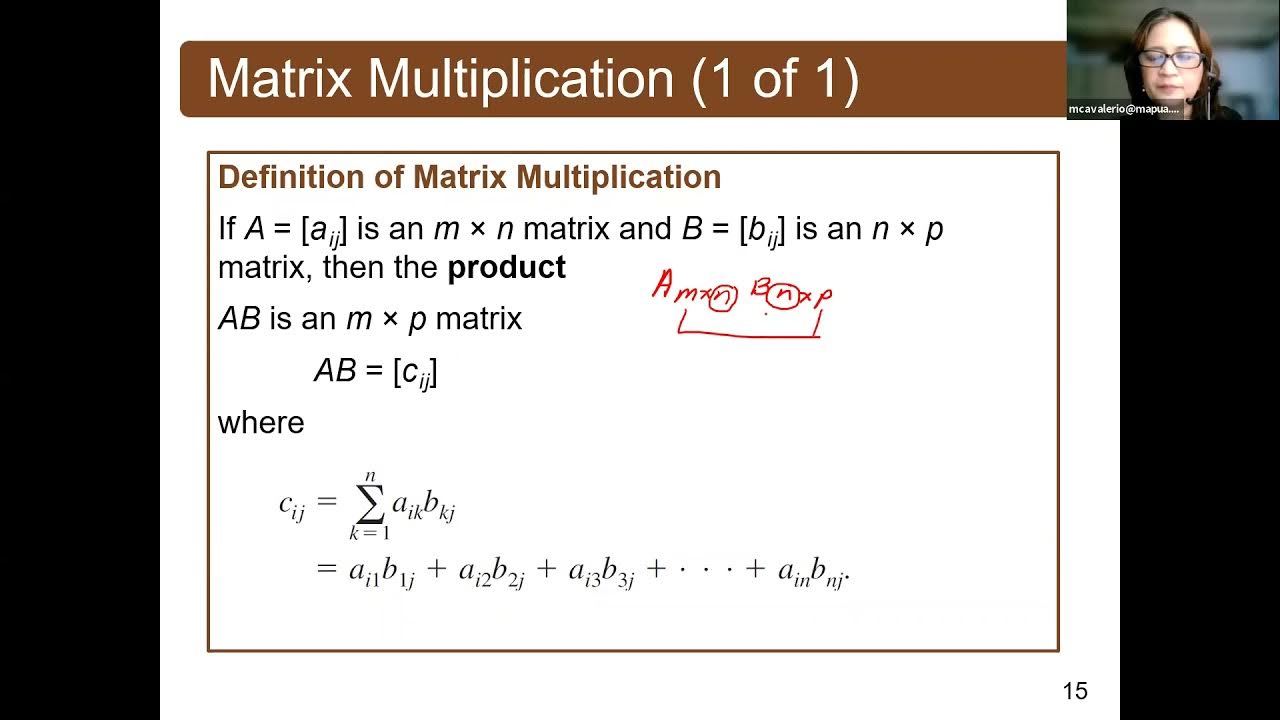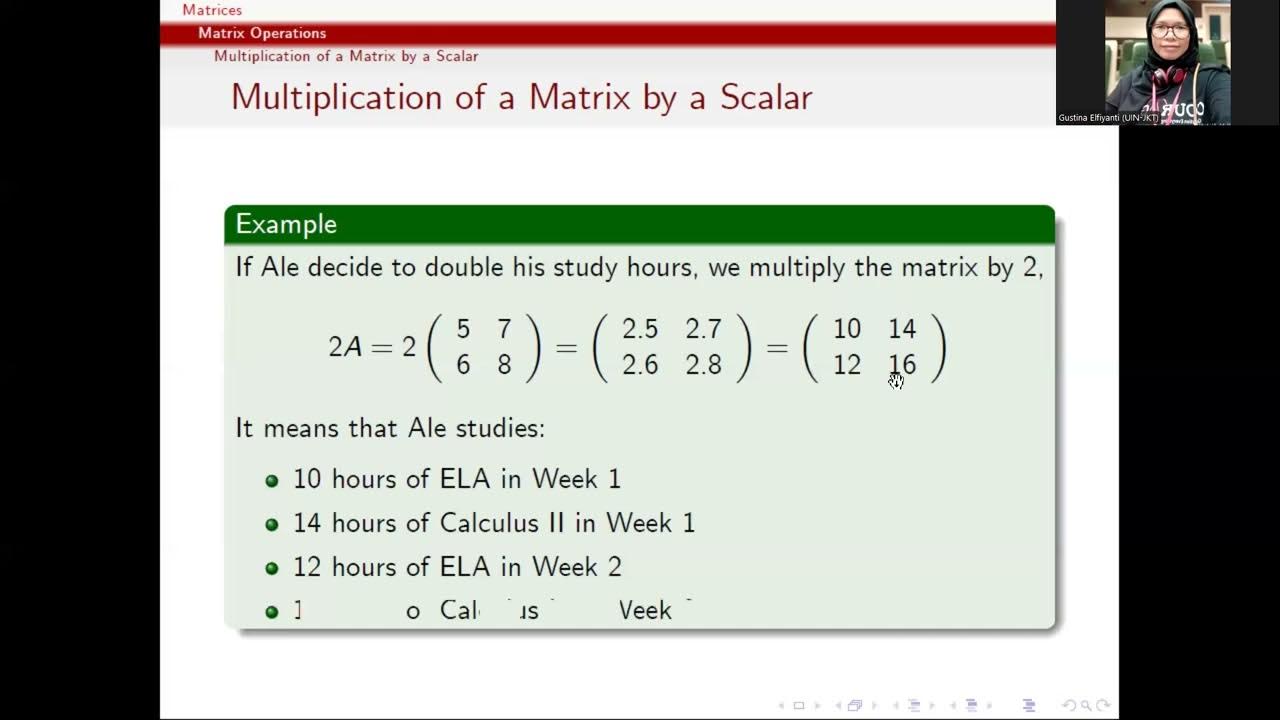MATH 140 Lecture: Section 1-1 (pg. 2 through 4)
Summary
TLDRThis video covers the fundamental operations of matrix addition and subtraction. It explains that for these operations to be valid, the matrices must be of the same size. The video walks through the process of adding and subtracting matrices by explaining how to subtract or add corresponding entries. Key examples include matrix operations with actual numerical values, as well as variables. The video also introduces important matrix properties like the commutative, associative, identity, and inverse properties, and concludes with practical examples demonstrating these concepts.
Takeaways
- 😀 Matrices must have the same dimensions for addition or subtraction to be possible.
- 😀 The resulting matrix from matrix addition or subtraction will have the same size as the original matrices.
- 😀 When adding or subtracting matrices, corresponding entries are combined (added or subtracted).
- 😀 Matrix subtraction must follow the correct order (A - B is not the same as B - A).
- 😀 Matrix addition and subtraction can only be performed when the matrices are the same size.
- 😀 Example 1: D and C are both 2x3 matrices, so subtraction is possible. The result is a 2x3 matrix.
- 😀 Matrix subtraction can be done manually or using a calculator with matrix operations.
- 😀 Example 2: C - B is not possible because C is a 2x3 matrix, and B is a 2x2 matrix.
- 😀 Example 3: A + B is possible because both A and B are 2x2 matrices, resulting in a 2x2 matrix.
- 😀 Commutative property: Matrix addition order does not matter (A + B = B + A).
- 😀 Identity property: Adding a zero matrix of the same size as a matrix results in the original matrix.
- 😀 Additive inverse: The additive inverse of a matrix changes the sign of every entry, and adding them results in the zero matrix.
- 😀 When matrices contain variables, operations must be performed manually, as calculators cannot process them.
Q & A
What is the first requirement when adding or subtracting matrices?
-The matrices must have the same dimensions. They must be of the same size in order to perform addition or subtraction.
What happens when two matrices of different sizes are added or subtracted?
-The operation is not possible because there are no corresponding entries to combine. Matrices must have the same dimensions for the operation to be valid.
How do you perform matrix addition?
-Matrix addition is performed by adding corresponding entries from each matrix. The result is a matrix with the same dimensions as the input matrices.
What is the result of subtracting matrix C from matrix D?
-The subtraction results in a matrix where each entry is the difference between the corresponding entries of matrices D and C. For example, D - C for the first entry is 6 - 3 = 3.
Why is the order of subtraction important when working with matrices?
-The order of subtraction matters because matrix subtraction is not commutative. That means A - B is not equal to B - A.
Can a calculator be used to perform matrix operations with variables?
-No, calculators can only handle matrix operations with numerical values. When matrices contain variables, the operations must be performed manually.
What should be done if the matrices are of different sizes and subtraction is attempted?
-If the matrices are of different sizes, the subtraction is not possible. You simply state that the operation cannot be completed due to the size mismatch.
What is the commutative property of matrix addition?
-The commutative property states that the order of addition does not affect the result. For matrices A and B, A + B is equal to B + A, provided both matrices have the same dimensions.
What does the associative property of matrix addition refer to?
-The associative property means that when adding three matrices, the grouping of the matrices does not affect the result. For example, (A + B) + C is equal to A + (B + C), as long as the matrices have the same size.
How do you find the additive inverse of a matrix?
-To find the additive inverse of a matrix, you change the sign of each entry. For example, if matrix B has entries [1, -11, 3y, 18], the additive inverse would be [-1, 11, -3y, -18].
Outlines

Dieser Bereich ist nur für Premium-Benutzer verfügbar. Bitte führen Sie ein Upgrade durch, um auf diesen Abschnitt zuzugreifen.
Upgrade durchführenMindmap

Dieser Bereich ist nur für Premium-Benutzer verfügbar. Bitte führen Sie ein Upgrade durch, um auf diesen Abschnitt zuzugreifen.
Upgrade durchführenKeywords

Dieser Bereich ist nur für Premium-Benutzer verfügbar. Bitte führen Sie ein Upgrade durch, um auf diesen Abschnitt zuzugreifen.
Upgrade durchführenHighlights

Dieser Bereich ist nur für Premium-Benutzer verfügbar. Bitte führen Sie ein Upgrade durch, um auf diesen Abschnitt zuzugreifen.
Upgrade durchführenTranscripts

Dieser Bereich ist nur für Premium-Benutzer verfügbar. Bitte führen Sie ein Upgrade durch, um auf diesen Abschnitt zuzugreifen.
Upgrade durchführen5.0 / 5 (0 votes)






